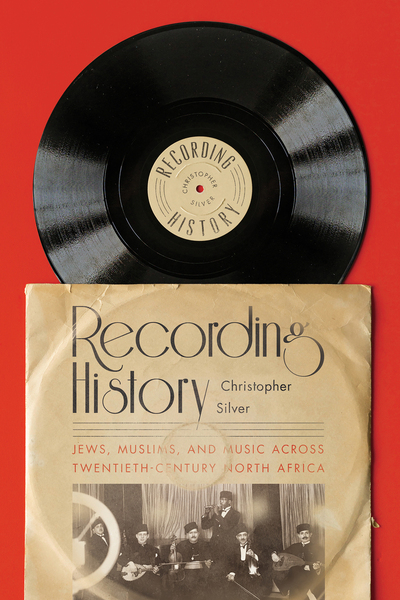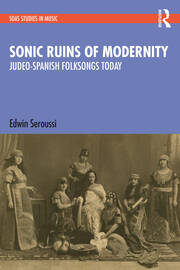You are currently browsing the tag archive for the ‘Sephardic Music’ tag.
“Ya Shema Evoynecha,” performed by Carla Berg, original poem in Hebrew by Yehuda Halevi, Ladino lyrics by Rabbi Reuven Eliyahu Yisrael, uploaded September 15, 2022, https://www.youtube.com/watch?v=v2QlJLkgeZw.
Reviewed by Lealiza Lee
The piyyut “Ya Shema Evoyonecha,” by Yehuda Halevi, is most widely known as a component of the Sephardic selichot service. Carla Berg is a vocalist who brings to light a long-forgotten Ladino version of the piyyut in a recording released for Rosh-Hashana.
Read the rest of this entry »Recording History: Jews, Muslims, and Music across Twentieth-Century North Africa. Christopher Silver. Stanford, CA: Stanford University Press. 2022.
Reviewed by Hugo Hadji

In Recording History: Jews, Muslims, and Music across Twentieth-Century North Africa, Christopher Silver provides the first in-depth and comprehensive history of the North African music recording industry and scene from the dawn of the twentieth century to the early post-independence era. Guided by the premise that music and history are mutually constitutive, Silver offers to listen to the sounds and artists that shaped and reflected the identities of Jews and Muslims living in the Maghreb region during that period. Such work, Silver convincingly argues, “provides twentieth-century North Africa with a soundscape that dramatically alters its historiographical landscape” (13) and allows us to use music to explore Jewish-Muslim relationships, coexistence, and subjectivities outside of and challenging the typical frameworks of “majority-minority” power relations and the mass departure of Jews in the 1950s and 1960s dominant in the literature. It further allows us to acknowledge and recount the central place Jews held in the construction and development of the recording industry and popular musical scene in North Africa, as artists and as intermediaries.
Read the rest of this entry »Sonic Ruins of Modernity: Judeo-Spanish Folksongs Today. Edwin Seroussi. London: Routledge. 2023.
Reviewed by Lori Sen

A minority within the Jewish people, Sephardim are a triple diasporic population, who carried with them their culture, traditions, language (Judeo-Spanish), and oral literature. Judeo-Spanish folksongs are among the Sephardim’s oral literature and reflect the diverse influences of the many cultures they encountered throughout their five-hundred-year-long journey from medieval Iberia to all over the modern world. With Sonic Ruins of Modernity, musicologist Edwin Seroussi introduces the contemporary concept of folksong (in the post-tradition era) as a sonic ruin, regularly visited by tourists interested in exploring the history of other cultures.
Read the rest of this entry »Cantos judeo-españoles: Simbología poética y visión del mundo [‘Judeo-Spanish Songs: Poetic Symbolism and Worldview’]. Silvia Hamui Sutton. With a prólogo by Vanessa Paloma. Santa Fe, NM: Gaon Books, 2008. 297 pp. ISBN 978-0-9820657-0-9 (hardcover) and 978-0-9820657-1-6 (softcover).
Reviewed by Israel J. Katz
 When I was invited to review this book, I was under the impression that it was written by an ethnomusicologist, given that it was advertised by its publisher under the categories Judaica, Ethnomusicology, and Spanish Traditions, and by a bookseller under Ethnomusicology, Sephardic songs, and Jewish music. To my surprise, I learned that its Mexican-born author obtained her university degrees in the fields of Latin-American Literature (Licenciatura from the Universidad Iberoamericana)[1] and Comparative Literature (earning both her masters degree and doctorate from the Universidad Nacional Autónoma de México). Even the title of her masters thesis, “Los símbolos de la naturaleza en los cantos judeo-españoles: una visión de la lírica popular hispánica [‘The symbols of nature in Judeo-Spanish song; a view of the Hispanic popular lyric’],” completed in 2003, and that of her doctoral dissertation, “Simbología poética y visión del mundo en los cantos judeo-españoles [‘Poetic symbolism and worldview in Judeo-Spanish song’],” submitted in 2006, clearly indicate that both deal solely with the lyrical/ poetic content of the songs she examined.[2] And, whereas both furnished the material for the monograph under review, one can only surmise that the confusion caused by referring to the book under review as an ethnomusicological work arose from commencing its title with Cantos Judeo-españoles. Read the rest of this entry »
When I was invited to review this book, I was under the impression that it was written by an ethnomusicologist, given that it was advertised by its publisher under the categories Judaica, Ethnomusicology, and Spanish Traditions, and by a bookseller under Ethnomusicology, Sephardic songs, and Jewish music. To my surprise, I learned that its Mexican-born author obtained her university degrees in the fields of Latin-American Literature (Licenciatura from the Universidad Iberoamericana)[1] and Comparative Literature (earning both her masters degree and doctorate from the Universidad Nacional Autónoma de México). Even the title of her masters thesis, “Los símbolos de la naturaleza en los cantos judeo-españoles: una visión de la lírica popular hispánica [‘The symbols of nature in Judeo-Spanish song; a view of the Hispanic popular lyric’],” completed in 2003, and that of her doctoral dissertation, “Simbología poética y visión del mundo en los cantos judeo-españoles [‘Poetic symbolism and worldview in Judeo-Spanish song’],” submitted in 2006, clearly indicate that both deal solely with the lyrical/ poetic content of the songs she examined.[2] And, whereas both furnished the material for the monograph under review, one can only surmise that the confusion caused by referring to the book under review as an ethnomusicological work arose from commencing its title with Cantos Judeo-españoles. Read the rest of this entry »
‘Empezar Quiero Contar’: Canciones de Sefarad. 2000. Pneuma PN-370. CD & booklet, 31 pages. Liner notes by Judith R. Cohen.
Sefarad en Diáspora. 2006. Pneuma PN-780. CD & booklet, 23 pages. Liner notes by Judith R. Cohen.
From the perspective of someone who derives little aesthetic pleasure from folksongs, but recognizes that bringing Jewish history to life in the classroom sometimes entails glancing up from conventional, printed texts, these recent CDs by ethnomusicologist and performer Judith R. Cohen are worthy of serious consideration. The use of traditional music in the classroom can help maintain attention spans. But music can also be a learning tool, and, as Cohen often demonstrates, some essential aspects of Jewish civilization can only be adequately contemplated by using our aural faculty.
Perspectives on Jewish Music: Secular and Sacred. Jonathan L. Friedmann, ed. Lanham, MD: Lexington Books, 2009. 162 pp. ISBN 978-0-7391-4152-6
Perspectives on Jewish Music, a collection of five essays addressing music in contemporary Jewish culture and personal Jewish history, is edited by Jonathan L. Friedmann, a cantor, string player, and author. In his introduction, Friedmann describes music as a tool of cultural preservation and emphasizes the role of music performance in defining Jewish personal and group identities throughout the Diaspora. Because of the many different contexts and conditions of Jewish life in the twentieth century, music has played a variety of roles and reflects a broad diversity of influences. This multiplicity of Jewish musical experiences is reflected in the disparate subjects of the book’s chapters.



